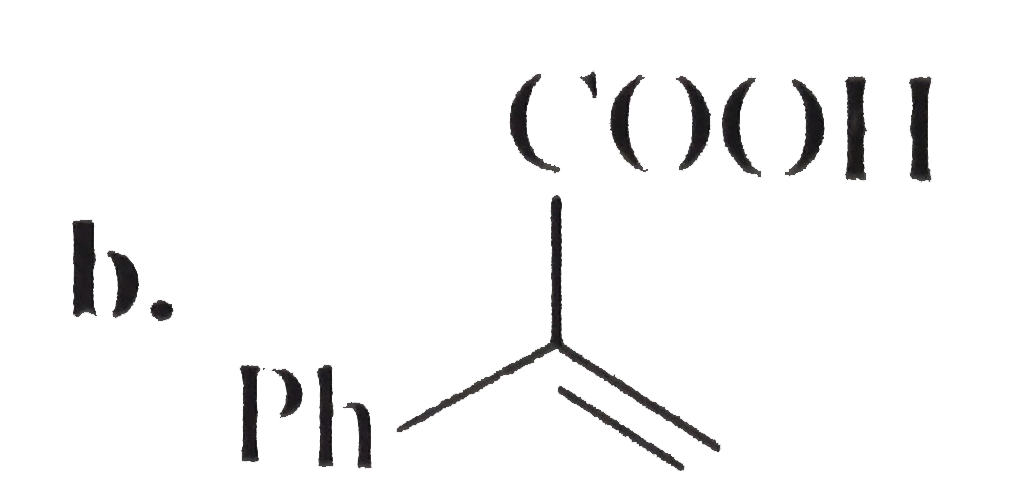How are carboxylic acids different from mineral acids from ionisation point of view?
Step-by-Step Solution:
1. Definition of Ionization:
- Ionization refers to the process by which an acid dissociates in an aqueous solution to release protons (H⁺ ions). The extent of this dissociation determines the strength of the acid.
2. Carboxylic Acids:
- Carboxylic acids have the general structure RCOOH, where R is a hydrocarbon group. For example, acetic acid (CH₃COOH) can be represented as CH₃C(=O)OH.
- When a carboxylic acid ionizes in water, it releases a proton (H⁺) to form a carboxylate ion (RCOO⁻). The ionization can be represented as:
RCOOH→RCOO−+H+
- Carboxylic acids are classified as weak acids because they only partially dissociate in solution (about 1-10% of the acid molecules ionize).
3. Mineral Acids:
- Mineral acids, such as hydrochloric acid (HCl) and sulfuric acid (H₂SO₄), are inorganic acids.
- When a mineral acid ionizes, it completely dissociates in water. For example, hydrochloric acid ionizes as follows:
HCl→H++Cl−
- Sulfuric acid, being dibasic, can release two protons:
H₂SO₄→2H++SO₄2−
- Mineral acids are classified as strong acids because they almost completely dissociate (close to 100%) in aqueous solutions.
4. Comparison:
- Extent of Ionization: Carboxylic acids are weak acids with partial ionization (1-10%), while mineral acids are strong acids with nearly complete ionization (close to 100%).
- Electrolyte Behavior: Carboxylic acids act as weak electrolytes, whereas mineral acids act as strong electrolytes in solution.
5. Conclusion:
- In summary, carboxylic acids differ from mineral acids in terms of their ionization behavior: carboxylic acids are weak acids that partially dissociate, while mineral acids are strong acids that fully dissociate in aqueous solutions.
- Ionization refers to the process by which an acid dissociates in an aqueous solution to release protons (H⁺ ions). The extent of this dissociation determines the strength of the acid.
- Carboxylic acids have the general structure RCOOH, where R is a hydrocarbon group. For example, acetic acid (CH₃COOH) can be represented as CH₃C(=O)OH.
- When a carboxylic acid ionizes in water, it releases a proton (H⁺) to form a carboxylate ion (RCOO⁻). The ionization can be represented as:
RCOOH→RCOO−+H+
- Carboxylic acids are classified as weak acids because they only partially dissociate in solution (about 1-10% of the acid molecules ionize).
- Mineral acids, such as hydrochloric acid (HCl) and sulfuric acid (H₂SO₄), are inorganic acids.
- When a mineral acid ionizes, it completely dissociates in water. For example, hydrochloric acid ionizes as follows:
HCl→H++Cl−
- Sulfuric acid, being dibasic, can release two protons:
H₂SO₄→2H++SO₄2−
- Mineral acids are classified as strong acids because they almost completely dissociate (close to 100%) in aqueous solutions.
- Extent of Ionization: Carboxylic acids are weak acids with partial ionization (1-10%), while mineral acids are strong acids with nearly complete ionization (close to 100%).
- Electrolyte Behavior: Carboxylic acids act as weak electrolytes, whereas mineral acids act as strong electrolytes in solution.
- In summary, carboxylic acids differ from mineral acids in terms of their ionization behavior: carboxylic acids are weak acids that partially dissociate, while mineral acids are strong acids that fully dissociate in aqueous solutions.
Topper's Solved these Questions
- BOOK - VK GLOBAL PUBLICATIONCHAPTER - CARBON AND ITS COMPOUNDSEXERCISE - PROFICIENCY EXERCISE (Very Short Answer Questions)6videos
CARBON AND ITS COMPOUNDS
- BOOK - VK GLOBAL PUBLICATIONCHAPTER - CARBON AND ITS COMPOUNDSEXERCISE - PROFICIENCY EXERCISE (Short Answer Questions-I)3videos
CARBON AND ITS COMPOUNDS
- BOOK - VK GLOBAL PUBLICATIONCHAPTER - CARBON AND ITS COMPOUNDSEXERCISE - LONG ANSWER QUESTIONS10videos
CARBON AND ITS COMPOUNDS
- BOOK - VK GLOBAL PUBLICATIONCHAPTER - ACIDS, BASES AND SALTS EXERCISE - PROFICIENCY EXERCISE ( Long Answer Questions (5 mark))4videos
ACIDS, BASES AND SALTS
- BOOK - VK GLOBAL PUBLICATIONCHAPTER - CHEMICAL REACTIONS AND EQUATIONSEXERCISE - PROFICIENCY EXERCISE (LONG ANSWER QUESTIONS)2videos
CHEMICAL REACTIONS AND EQUATIONS
Similar Questions
Knowledge Check
- Question 1 - Select One

Carboxylic acid (A) is:A B
B C
C DBoth (a) and (c )
DBoth (a) and (c ) - Question 2 - Select One
Carboxylic acids undergo ionisation due to
Aabsence of α−hydrogenBresonance satabilisatio of carboxylate ionChigh reactivity of compoundDhydrogen bonding - Question 3 - Select One or More
Carboxylic acids can be obtained from :
AnitrilesBestersCalcoholsDalkanes
How is the neutralisation of a carbonate with an acid different from the neutralisation of an oxide or a hydroxide?
View SolutionWhy is carboxylic acid a stronger acid than phenol ?
View SolutionMineral acids are stronger acids than carboxylic acids because
(i) mineral acids are completely ionised.
(ii) carboxylic acids are completely ionised.
(iii) mineral acids are partially ionised.
(iv) carboxylic acids are partially ionised.View SolutionWhich of the following acids is a mineral acid ?
View SolutionCarboxylic acids are acidic in nature because :
View Solution

